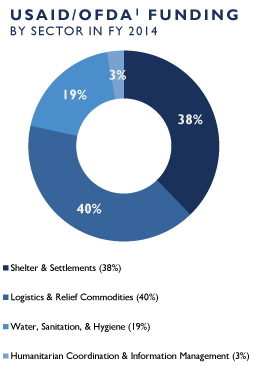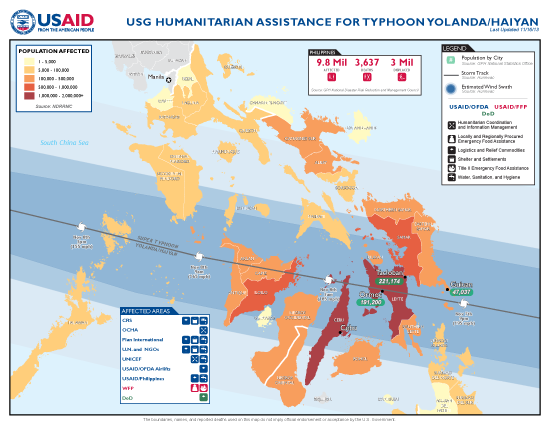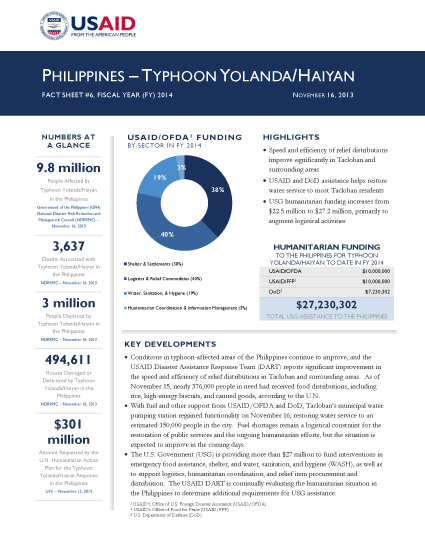- What We Do
- Agriculture and Food Security
- Democracy, Human Rights and Governance
- Economic Growth and Trade
- Education
- Ending Extreme Poverty
- Environment and Global Climate Change
- Gender Equality and Women's Empowerment
- Global Health
- Water and Sanitation
- Working in Crises and Conflict
- Disaster Assistance
- Political Transition Initiatives
- Conflict Mitigation and Prevention
- Countering Violent Extremism
- Disaster Risk Reduction
- Peacebuilding and Reconciliation
- Providing Safe & Secure Environments for Development
- Recovering From Crisis
- Resilience
- Tech Challenge for Atrocity Prevention
- World Humanitarian Day
- U.S. Global Development Lab
November 16, 2013
Numbers At A Glance
9.8 million
3,637
3 million
494,611
$301 million
Humanitarian Funding:
To The Philippines For Typhoon Haiyan/Yolanda To Date In FY2014:

| USAID/OFDA | $10,000,000 |
| USAID/FFP | $10,000,000 |
| DoD | $7,230,302 |
| TOTAL | $27,230,302 |
Typhoon Haiyan / Yolanda Fact Sheet #6 - 11/16/2013 ![]() (pdf - 204k)
(pdf - 204k)
Highlights
Speed and efficiency of relief distributions improve significantly in Tacloban and surrounding areas
USAID and DoD assistance helps restore water service to most Tacloban residents
USG humanitarian funding increases from $22.5 million to $27.2 million, primarily to augment logistical activities
Key Developments
Conditions in typhoon-affected areas of the Philippines continue to improve, and the USAID Disaster Assistance Response Team (DART) reports significant improvement in the speed and efficiency of relief distributions in Tacloban and surrounding areas. As of November 15, nearly 376,000 people in need had received food distributions, including rice, high-energy biscuits, and canned goods, according to the U.N.
With fuel and other support from USAID/OFDA and DoD, Tacloban’s municipal water pumping station regained functionality on November 16, restoring water service to an estimated 150,000 people in the city. Fuel shortages remain a logistical constraint for the restoration of public services and the ongoing humanitarian efforts, but the situation is expected to improve in the coming days.
The U.S. Government (USG) is providing more than $27 million to fund interventions in emergency food assistance, shelter, and water, sanitation, and hygiene (WASH), as well as to support logistics, humanitarian coordination, and relief item procurement and distribution. The USAID DART is continually evaluating the humanitarian situation in the Philippines to determine additional requirements for USG assistance.
WASH
- As of November 16, fuel provisions coordinated by USAID/OFDA and DoD enabled Tacloban’s municipal water pumping station to regain functionality, restoring water service throughout the city for an estimated 150,000 residents. While undamaged by the storm, Tacloban’s water system had been unable to resume full operation as a result of fuel shortages in the aftermath of the typhoon.
- USAID/OFDA and DoD plan to continue the support necessary to maintain Tacloban’s water production in the coming days, until the GPH and humanitarian partners can organize additional fuel suppliers.
- USAID/OFDA had also provided the U.N. Children’s Fund (UNICEF), one of the lead agencies for the WASH Cluster, with $750,000 to procure a generator to help restore power to Tacloban’s municipal water system. To date, USAID/OFDA has provided approximately $1.6 million for WASH activities in storm-affected areas.
LOGISTICS AND RELIEF COMMODITIES
- Fuel shortages remain a major logistical constraint in typhoon-affected areas of the Philippines, hampering ongoing humanitarian efforts and the restoration of public services. However, most fuel stores are reportedly unaffected by the typhoon, and fuel is expected to become increasingly available as transportation networks continue to reopen in the coming days. The U.N. reports that the Shell oil company plans to make available 20,000 liters of fuel beginning on November 17.
- The Logistics Cluster, the coordinating body for humanitarian logistics activities in the Philippines, continues working to procure trucks, barges, and other vehicles to facilitate humanitarian aid deliveries. The cluster has mobilized 16 trucks to help increase food distribution capacity to 400 metric tons (MT) per day for Tacloban and surrounding areas. Eight of the trucks arrived in Tacloban on November 16, and another eight are scheduled to arrive the following day.
- On November 16, USAID DART members noted significant improvements in the speed and efficiency of relief supply distributions at the GPH Department of Social Welfare and Development (DSWD) warehouse in Tacloban. The DART also visited a portion of the most-affected areas of Tacloban and observed rapid improvements in road clearing and clean-up operations.
- The USAID DART has established a forward operating base at Tacloban, posting a logistics officer and a military liaison officer at the city’s airport to strengthen coordination with other humanitarian stakeholders and enable closer tracking of USG commodities scheduled for distribution.
- On November 16, U.S. military assets delivered approximately 32.7 MT of USAID-validated emergency relief commodities to typhoon-affected communities. DoD also recently established a forward area refueling point at Guiuan, which will enable additional air deliveries of relief supplies to outlying areas. In addition, DoD is working to secure 30 three-ton trucks and five tractor trailers to assist with ground distributions.
- To date, DoD has contributed more than $7 million for the Typhoon Yolanda/Haiyan response, primarily for airlifts and other logistical support. USAID/OFDA has provided approximately $3.5 million—representing approximately 40 percent of USAID/OFDA funding to date—for logistics support and relief commodities.
FOOD SECURITY
- As of November 16, Typhoon Yolanda/Haiyan had destroyed approximately 384,000 acres of land planted with rice, corn, and other crops, causing more than $105 million in agricultural damages, according to the NDRRMC.
- The U.N. has noted a time-critical priority to provide rice seeds and other agricultural inputs to farmers by mid-December to allow them to replant lost crops during the ongoing rainy season, thereby securing a March/April rice harvest. As of November 16, relief agencies working in the food security sector had mobilized sufficient quantities of rice seeds, vegetable seeds, and agricultural tools to assist approximately 11,300 farming households for the rainy season, according to the U.N.
- Increasing quantities of food distributions are reaching populations in need. Nearly 376,000 people in need had received food distributions, including rice, high-energy biscuits, and canned goods, as of November 15, according to U.N. reports. The majority—approximately 275,000 individuals—obtained DSWD food packs, which included rice rations provided by the U.N. World Food Program (WFP) with USAID/FFP support. Each DSWD food pack contains canned goods and more than 6 pounds of rice and is sufficient to feed a family of five for up to three days.
- With USAID/FFP funding, WFP plans to locally procure an additional 10,000 MT of rice. This contribution provides WFP with sufficient quantities of rice to meet current and near-term needs. The rice will be added to DSWD food packs to assist populations affected by the typhoon.
- To date, USAID/FFP has committed $10 million toward WFP’s response in the Philippines.
INTERNATIONAL ASSISTANCE
- As of November 16, international donors had pledged approximately $166.7 million to address humanitarian needs among populations affected by Typhoon Yolanda/Haiyan. The total amount pledged represents approximately 55 percent of the $301 million requested by the U.N. Humanitarian Action Plan for the Philippines typhoon response.
- On November 16, during her visit to the Philippines, European Commissioner for International Cooperation, Humanitarian Aid, and Crisis Response Kristalina Georgieva announced an increase of €7 million—or approximately $9.4 million—in European Commission humanitarian assistance. This latest contribution brings the Commission’s total humanitarian funding to €10 million, or approximately $13.5 million. The Commission has also pledged €10 million for recovery and reconstruction efforts.









Comment
Make a general inquiry or suggest an improvement.